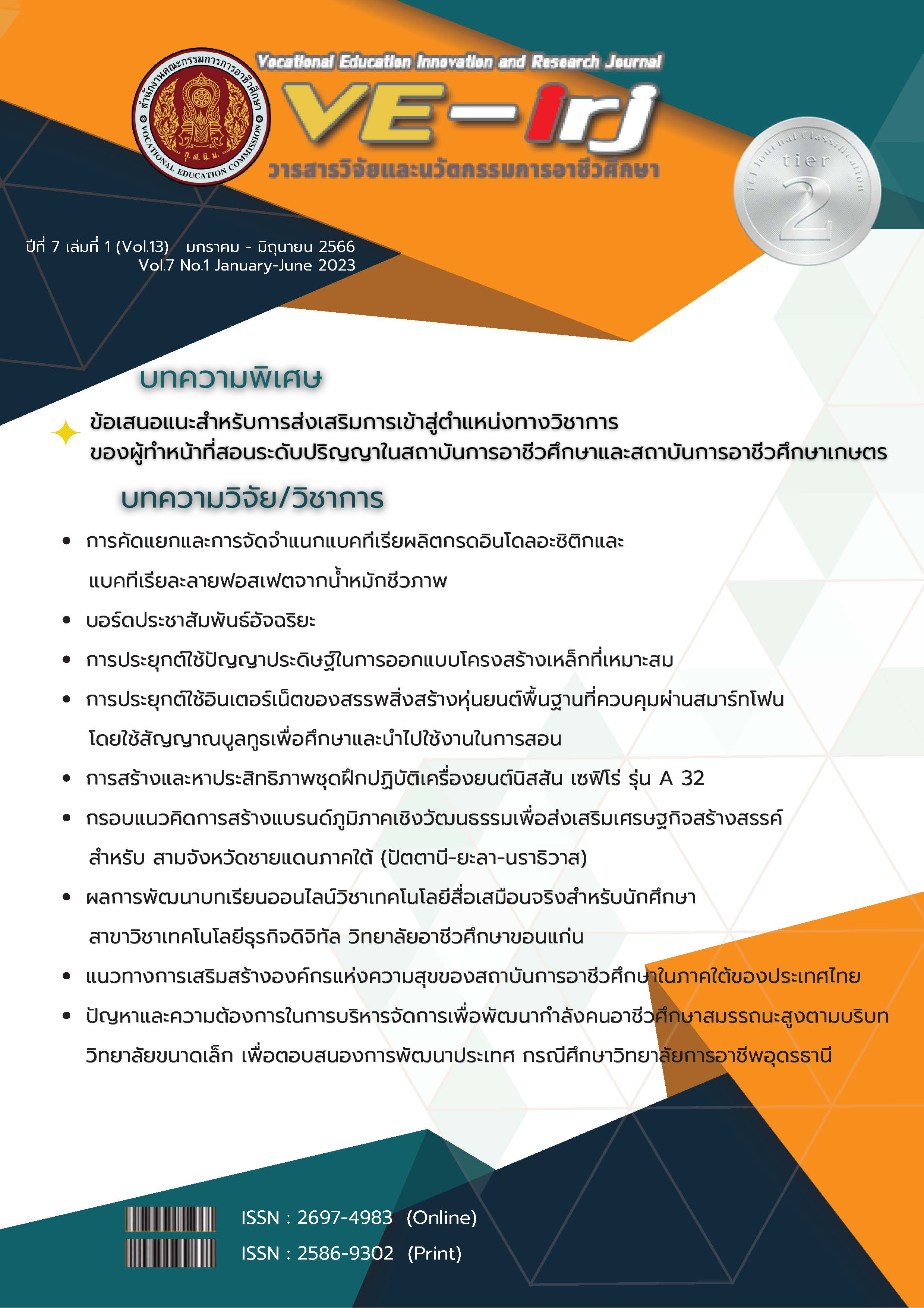การคัดแยกและการจัดจำแนกแบคทีเรียผลิตกรดอินโดลอะซิติกและแบคทีเรียละลายฟอสเฟตจากน้ำหมักชีวภาพ
Main Article Content
บทคัดย่อ
น้ำหมักชีวภาพถูกนำมาใช้ประโยชน์ทางการเกษตรโดยนำมาทำเป็นปุ๋ยทดแทน หรือใช้ผสมอาหารสัตว์ อย่างไรก็ตามคุณภาพของน้ำหมักนั้นมีความแตกต่างกันไปขึ้นอยู่กับสูตรอาหาร และกระบวนการหมักที่เกิดโดยจุลินทรีย์ในธรรมชาติ งานวิจัยนี้จึงมีวัตถุประสงค์เพื่อคัดเลือกแบคทีเรียส่งเสริมการเจริญของพืชซึ่งผลิต indole-3-acetic acid (IAA) และแบคทีเรียละลายฟอสเฟต เพื่อทำการจัดจำแนกในระดับอณูชีวโมเลกุล จากการทดลองทำการหมักน้ำหมักชีวภาพจากหัวเชื้อที่เตรียมจากถั่วเหลืองบดเป็นผง ที่เติมยีสต์สกัดร้อยละ 2 โดยน้ำหนัก ทำการหมักโดยใช้อาหารประกอบด้วย Peptone 10 กรัม ข้าวโพดบด 5 กรัม สารสกัดจากเนื้อ 2.5 กรัม ปลาป่น 1.5 กรัม สารสกัดจากยีสต์ 3 กรัม น้ำตาลปีบ 2 กรัม เกลือ 1 กรัม รำละเอียด 1 กรัม เลือดหมู 1 กรัม น้ำ 1 ลิตร ทำการหมักจนค่า pH อยู่ระหว่าง 2-3 พบว่าแยกแบคทีเรียได้ทั้งหมด 29 ไอโซเลต พบแบคทีเรียที่ผลิต IAA ได้ 8 ไอโซเลตที่สามารถผลิต IAA ได้ (27.5%) ได้แก่ Lactobacillus casei NV2203 Lacticaseibacillus rhamnosus NV2207 Bacillus cereus NV2210 Bacillus cereus NV2211 Lacticaseibacillus rhamnosus NV2214 Bacillus sp. NV2226 Terribacillus sp. NV2230 และ Terribacillus saccharophilus NV2233 และพบแบคทีเรียละลายฟอสเฟต 2 ไอโซเลต ได้แก่ Lactobacillus casei NV2203 และ Bacillus subtilis NV2206 ซึ่งแบคทีเรียเหล่านี้สามารถนำไปใช้เป็นหัวเชื้อเพื่อควบคุมคุณภาพของน้ำหมักชีวภาพให้มีประสิทธิภาพดียิ่งขึ้น
Article Details

อนุญาตภายใต้เงื่อนไข Creative Commons Attribution-NonCommercial-NoDerivatives 4.0 International License.
สงวนสิทธิ์ โดย สถาบันการอาชีวศึกษาภาคตะวันออกเฉียงเหนือ 1
306 หมู่ 5 ถนนมิตรภาพ หนองคาย-อุดรธานี ตำบลโพธิ์ชัย อำเภอเมืองหนองคาย จังหวัดหนองคาย 43000
โทร 0-4241-1445,0-4241-1447
ISSN : 3027-6861 (print) ISSN : 3027-687X (online)
เอกสารอ้างอิง
P. Pindi and S. Satyanarayana. “Liquid microbial consortium- a potential tool for sustainable soil health”. Journal of Biofertilizers and Biopesticides, 3(4), pp. 1-9, 2012.
F. Ahmad, I. Ahmad, and M. Khan. “Screening of free-living rhizospheric bacteria for their multiple plant growth promoting activities”. Microbiological Research, 163(2), pp. 173-181, 2008.
ฌานิกา แซ่แง่ ชูกลิ่น, เอนก สาวะอินทร์ และ สุดนัย เคลือหลี, “ผลของน้ำหมักชีวภาพจากเศษปลาเหลือทิ้งด้วยเชื้อ Lactobacillus casei ต่อการเจริญเติบโตและผลผลิตของผักกวางตุ้งฮ่องเต”. วารสารวิจัยมหาวิทยาลัยเทคโนโลยีราชมงคลศรีวิชัย. ฉบับที่ 14(1), พ.ศ. 2565, หน้า 253-265.
ศศิธร กู้สุวรรณวิจิตร, สุดารัตน์ ตรีเพชรกุล และ แสงชัย เอกประทุมชัย, “การผลิตน้ำหมักชีวภาพจากน้ำทิ้งในกระบวนการผลิตน้ำมันมะพร้าวบริสุทธิ์: อิทธิพลของชนิดน้ำตาล” วารสารวิจัยและพัฒนา มจธ. ฉบับที่ 4, พ.ศ. 2557, หน้า 447-466.
H. Lu, Z. Wu, W. Wang, X. Xu and X. Liu. “Rs-198 Liquid biofertilizers affect microbial community diversity and enzyme activities and promote Vitis vinifera L. growth”. BioMedical Research International, 2020, pp. 1-10, 2020.
N.T.H. Nhu, N. L. Chuen and N. Riddech. “The effects bio-fertilizer and liquid organic fertilizer on the growth of vegetables in the pot experiment”. Chiang Mai Journal of Science, 45(3), pp. 1257-1273, 2018.
ณัฐวุฒิ เพชรนวล, ปฐมาภรณ์ ทิลารักษ์, พิริยาภรณ์ อันอาตม์งาม และ อมรรัตน์ สุวรรณโพธิ์ศรี, “ปุ๋ยชีวภาพจากจุลินทรีย์โพรไบโอติกของพืช” วารสารเกษตรศาสตร์และเทคโนโลยี ปีที่ 1 ฉบับที่ 3, พ.ศ. 2563, หน้า 12-21.
A. Kumar, P. Sharma, M. Gomar-Alba, Z. Shcheprova, A. Daulny, T. Sanmartín, I. Matucci, C. Funaya, M. Beato and M. Mendoza. “Daughter-cell-specific modulation of nuclear pore complexes controls cell cycle entry during asymmetric division”. Nature Cell Biology, 20(4), pp. 432-442, 2018.
A. Kumar, P. Sharma, M. Gomar-Alba, Z. Shcheprova, A. Daulny, T. Sanmartín, I. Matucci, C. Funaya, M. Beato and M. Mendoza. “Daughter-cell-specific modulation of nuclear pore complexes controls cell cycle entry during asymmetric division”. Nature Cell Biology, 20(4), pp. 432-442, 2018.
S. Zaidi, S. Usmani, B. Singh and J. Musarrat. “Significance of Bacillus subtilis strain SJ-101 as a bioinoculant for concurrent plant growth promotion and nickel accumulation in Brassica juncea”. Chemosphere, 64(6), pp. 991-997, 2006.
S. Zaidi, S. Usmani, B.R. Singh and J. Musarrat. “Significance of Bacillus subtilis strain SJ-101 as a bioinoculant for concurrent plant growth promotion and nickel accumulation in Brassica juncea”. Chemosphere, 64(6), pp. 991-997, 2006.
R. Hayat, S. Ali, U. Amara, R. Khalid and I. Ahmed. “Soil beneficial bacteria and their role in plant growth promotion: a review. Annual Microbiology, 60, pp. 579-598, 2010.
S. Anupama, K. Beom Seok and P. Duck Hwan. “Biological control of bacterial spot disease and plant growth-promoting effects of lactic acid bacteria on pepper”. Biocontrol Science and Technology, 24(7), pp. 763–779, 2014.


